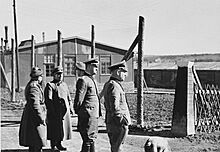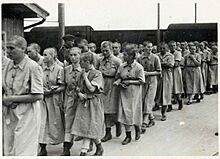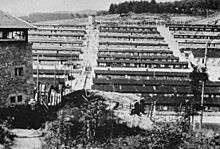List of Nazi concentration camps facts for kids
Quick facts for kids Nazi concentration camps |
|
|---|---|

SS men and barracks at Hinzert
|
|

Jewish women selected for work at Auschwitz II-Birkenau
|
|

View of Flossenbürg after liberation
|
During World War II, the Nazis created many places called concentration camps. These were special prisons where people were held against their will. The Nazis used these camps to control and punish anyone they saw as enemies. This included political opponents, Jewish people, Roma people, homosexuals, and many others.
Life in these camps was very hard. Prisoners faced starvation, forced labor, and terrible conditions. Many people died in these camps due to disease, mistreatment, or being killed. Historians believe there were at least a thousand Nazi concentration camps and their smaller satellite camps. They were not all open at the same time, but they were spread across Europe.
What Were Nazi Camps?
Nazi concentration camps were part of a system of terror. The German government, led by Adolf Hitler and the Nazi Party, used these camps to imprison millions of people. These camps were not like regular prisons. They were designed to break people's spirits and, in many cases, to kill them.
The camps were run by the SS, a powerful Nazi organization. They controlled every part of the prisoners' lives. People were sent to these camps without a fair trial. They often did not know why they were there or when they would leave.
Types of Camps
The Nazi camp system grew over time. It started with smaller camps and later included very large ones. These camps had different purposes, but all were places of extreme suffering.
Early Camps
The first concentration camps were set up very early. This was soon after the Nazis came to power in 1933. These early camps were mainly for political opponents. People who spoke out against the Nazis were arrested. They were sent to these camps to be silenced.
Some of these early camps included:
- Columbia concentration camp
- Dachau concentration camp
- Oranienburg concentration camp
- Sachsenburg concentration camp
These camps were often small and temporary. But they set the stage for the much larger and more brutal camps that came later.
Main Camps
As World War II continued, the camp system grew much bigger. The Nazis built many large "main camps." These camps had many smaller "satellite camps" connected to them. Prisoners from the main camps were often sent to work in these smaller camps.
These main camps were used for forced labor. Prisoners were made to work in factories, mines, or farms. They worked in terrible conditions with little food. Many people died from exhaustion and hunger. Some of these camps also became places where large numbers of people were killed.
Some of the most well-known main camps included:
- Auschwitz concentration camp: This was the largest and most deadly camp. It was a place where many Jewish people were killed.
- Bergen-Belsen concentration camp: This camp became famous after the war. Many prisoners died there from disease and starvation.
- Buchenwald concentration camp: This was one of the largest camps in Germany. It held political prisoners and many others.
- Dachau concentration camp: This was the first permanent concentration camp. It was a model for later camps.
- Flossenbürg concentration camp: This camp was known for its granite quarry. Prisoners were forced to work there.
- Majdanek concentration camp: This camp was located near a city in Poland. It was both a labor camp and a killing center.
- Mauthausen concentration camp: This was one of the harshest camps. It was known for its brutal conditions.
- Ravensbrück concentration camp: This was the main concentration camp for women.
- Sachsenhausen concentration camp: This camp was close to Berlin. It held many political prisoners.
- Stutthof concentration camp: This camp was one of the first camps set up outside Germany.
Each of these main camps had many smaller camps linked to them. These satellite camps were often built near factories or mines. Prisoners were forced to work in these places to support the Nazi war effort.
Images for kids
See also
In Spanish: Anexo:Campos de concentración nazis para niños





